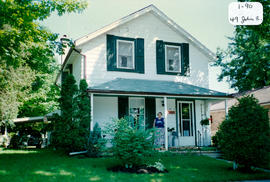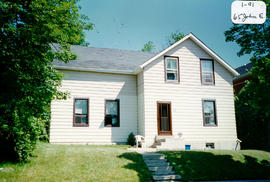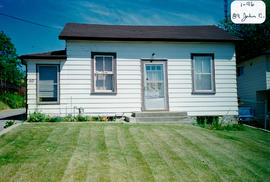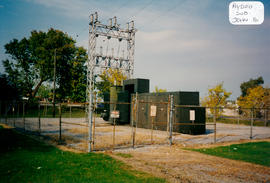- CA BWGPL GJ-HB-2017-04-04-10
- Stuk
- 1996
Part of George Jackson fonds
The house located at 49 John St. East (on the northwest corner of Nelson and John Streets) was built around 1860-1880 in the Gothic Revival style. There was once a large garden on the east side and a small drainage ditch north of the laneway. Dave Ogilvie and his wife May (McKinstry) purchased this house around 1920. Dave had a livery stable, a jitney, and a taxi service. He also carried mail between the (railroad?) station, the Post Office and Bond Head. The taxi and jitney went to Newmarket to meet York Radial street cars. The Ogilvie family moved across the street and the building later became a boarding house that was run by Mr. and Mrs. Jones. It eventually became the home of the Morton family (retired farmers from the Scotch Settlement). At the time of this photo (1995), it was the home of Everett and Marie McVety.
The two-storey, rectangular building has a medium-pitched, gable roof and large window openings with high floor to ceiling heights. There are 2/2 wood, sash windows that have plain, wood lug sills and wood trim. The ground-floor front window is original. It is possible that the wooden shutters may also be original. There is a Regency-like, wide, front porch. The original porch columns have been replaced with simple, square, wooden ones. This structure has vinyl siding on wood frame construction and there is a stone foundation. The original cladding was probably wood cove siding. According to the 2000 inventory, the simple house is well-maintained and has much of its original character.
(1, 2, 3)
Zonder titel










